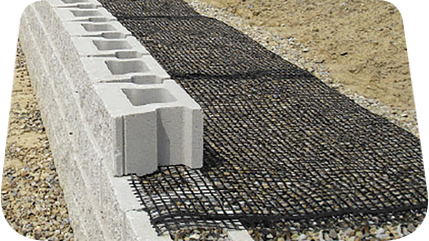 Using Geogrid to Reinforce a Retaining Wall Using Geogrid to Reinforce a Retaining Wall
The following provides guidance for installation a retaining wall when using blocks from
Allen Block.
If your project involves stabilizing slopes or earth retention you will need to use geogrid. Geogrid is a synthetic, flexible mesh that is specifically made for these purposes. Geogrid comes in an array of materials, strengths, and sizes. They are made of plastic that is woven polyester or high tensile strength that is provided in rolls. It is available in both uniaxial and biaxial form. Biaxial geogrid is most commonly used in projects where the retaining wall is under 10 feet. This type of geogrid can be rolled both in the direction of the wall or away from the wall and will still remain strength where uniaxial can only be rolled out in one direction for it's reinforcement properties to stay intact.
First, you should use the Soil Reinforcement Chart in order to determine the size of AB grid you will need and how many layers will be required for your retaining wall.
How Does Geogrid Work?
You will want to perform a few tests, to begin with. Take two cylinders, one that has compacted material and the second that has compacted material along with mesh that represents geogrid. Take both cylinders and apply vertical force to see how the soil reacts.
AB Aztec Or AB Europa Walls:
Once you have completed the foundation, start installing the first layer of Reinforcement Grid. Using either AB Aztec or AB Europa, place the edge of the geogrid up against the back of the raised front edge and roll it out along the wall. Place the edge of the geogrid in the middle of the facing unit for AB Fieldstone. You should always refer to your plans to know the exact location and size.
The next step, place the block in order for the seams to counterbalance from the blocks by at least 1/4 in length Observe the line of the retaining wall for alignment. You may adjust the blocks somewhat to form a straight line.
Take the back of the geogrid and pull on it in order to remove any slack and if required, stake it into place. Never compact or drive on the geogrid or you will damage it.
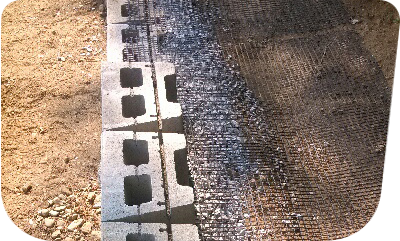 Compacting & Backfilling: Compacting & Backfilling:
Install the wall rock in the block cores, 12 inches (300mm) behind the block. Use the approved on-site soils or infill to backfill behind the wall rock to the exact height of the block. Make sure the wall rock and soil, behind the wall, is properly compacted by using a plate compactor.
Compact in lifts of 8 inches (200mm) or less. Start on the blocks and work in the direction that is parallel to the block heading toward the back of the excavation area. Go over this with at least 2 passes with the plate compactor. The compaction should provide soil that is solid and free of any movement. Remove all excess material from the top surfaces of the blocks and ensure all surfaces are clean and smooth for the next step.
At this point, continue installing your next level of blocks using the same steps as just mentioned. Using your plan, install the geogrid on every procedure of the retaining wall. Going through all the steps, complete the wall to the desired height. The last step, fill behind the blocks with an organic soil in place or the approved on-site soil. This will prevent water from running behind the blocks and help in plantings above the retaining wall.
AB Fieldstone Walls:
First off, refer to the approved plans for placing geogrid. Cut sections of the geogrid to the specified lengths as mentioned in the approved plans. Always check the manufacturer's grid specs for strength, roll or machine direction.
After the foundation of blocks has been installed, roll out the geogrid starting in the center of the AB Fieldstone facing and then extend back to the excavated area. Stack the next set of blocks (facing/anchoring unit) in order for the blocks to be offset from the foundation blocks. Each of the procedures should be placed with the vertical seams offset by at least 3 inches (75mm) or ¼ the length of the blocks. Take the geogrid and pull to remove any slack and then stake in place before installation of the wall rock and the approved infill soil. Never run the compaction equipment on to the geogrid.
Patterned Walls:
If you'd like to give a unique look to your landscape, try applying a patterned wall. You can blend the different sizes of blocks together into the wall and create a hand-laid stone look. Choose from an array of pre-set patterns to create your wall or design your own. If you have walls that need reinforcement or are curved, you will have to construct with a two procedure pattern.
Creating A Patterned Retaining Wall:
In order to create a wall that looks like a hand-laid wall requires a good amount of craftsmanship and detail. This will require a certain amount of custom fitting of the blocks. You should allow for extra time to create this wall especially if you are doing this for the first time.
You can use either the AB Europa or the AB Collection to create a pattern that is pre-set or irregular. A preset pattern is repeated every 2 or 3 sets of blocks. See the Pattern Chart for further details.
A single procedure of one full-sized block should be around 8 inches (200mm) high. A level surface is required on the reinforced wall for an irregular pattern in order to properly install the geogrid. Always refer to your approved plan before the placement of geogrid.
Walls with curves should always use the 2 procedure pattern to cut back on fitting and cutting. This also applies to wall requiring geogrid in order to ensure proper placement of the geogrid.
Biaxial Geogrid 101: Common Applications and Typical Uses
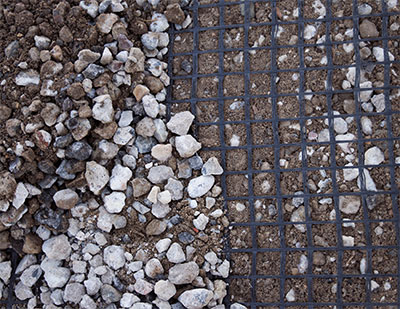 Stability
is a key component in creating landscapes that last and won’t deteriorate or
erode over time. As anyone who has worked on a failing road, or building a
retaining wall knows, soil erosion can wreak havoc sloped hillsides or retention
areas. Many wonder how what biaxial geogrids are and how they can help with
retaining wall and road construction? Stability
is a key component in creating landscapes that last and won’t deteriorate or
erode over time. As anyone who has worked on a failing road, or building a
retaining wall knows, soil erosion can wreak havoc sloped hillsides or retention
areas. Many wonder how what biaxial geogrids are and how they can help with
retaining wall and road construction?
Geogrid is composite or plastic lattice structures used to reinforce roads, retaining
walls, and prevent against soil erosion. A Biaxial geogrid provides the same
stabilizing strength in both the latitudinal and longitudinal (X & Y)
directions. This geogrid is durable and made from sheet punched or extruded
polymers.
Using a biaxial grid is a great preventative measure
against the forces of erosion. Read on to learn the basics of this tool and what
makes it so useful for both wall and roadway constuction.
What
are Geogrids?
Before covering the unique features that make geogrids useful, let's understand geogrids in a general sense.
Geogrid Definition
Geogrid – A synthetic material used to reinforce
soils as a part of the construction process.
Builders use geogrids to
increase the structural integrity of soils. They accomplish this by laying the
geogrid across the soil or embedding the geogrid into the soil in layers.
Geogrid Materials
These grids are made from polymers.
Some common polymeric materials used to create geogrids include the following:
• Polyester
• Polyethylene
• Polypropylene
Geogrid
Classifications
Geogrids can have many applications and come in many
forms. Often, geogrid classifications are based on their woven pattern. Two of
the most common classifications are below.
1. Uniaxial geogrids (provide
strength in a single longitudinal direction)
2. Biaxial geogrids (provide
strength in both latitude and longitudinal directions)
Geogrid
Components
Three geometrical components comprise each pattern:
1.
Ribs – Strips of the polymer material which cross each other forming apertures
2. Junction – The point at which the ribs cross
3. Aperture – The space, or
grid cell, created by the crossing ribs
Uniaxial geogrids have apertures
that are narrow in one direction and long in the other. This leads them to have
a high level of strength in only one direction.
Geogrids look
more like a traditional grid. The ribs appear at regular increments in both
directions, thereby creating rectangular apertures.
Each type of geogrid has its own unique
characteristics and applications. But geogrids also share common traits that
make them useful in a general sense.
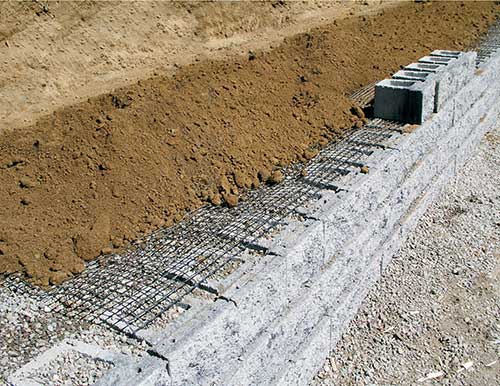 Useful Properties of
Geogrids Useful Properties of
Geogrids
We have established that geogrids are useful in preventing
erosion. But how exactly do they accomplish this?
Some of the useful
properties of geogrids include:
• Tensile Strength – Resistance to
breaking when placed under tension
• Radial Stiffness – Distribution of loads
in all directions
• Confinement – Prevention of granular material, such as
soil, from shifting
Using a geogrid usually involves laying large sheets
of the geogrid on the soil then covering it with more soil. As the soil covers
the geogrid, the ribs lock the soil particles in place.
It's the ribs'
strength that allows the soil particles to stay in place, making for a
longer-lasting erosion-resistant soil.
Reduced Need for
Maintenance
Because geogrids do such an admirable job of holding
soil in place,
there is little likelihood that a foundation containing
geogrids will ever need maintenance or repair and, subsequently, neither will
the structures that rest on a geogrid-lined foundation.
Additionally, geogrids retain their tensile strength and soil-holding properties
and not break down over time. They are highly resistant to the soil
microorganisms, chemicals, UV rays, and mechanical damage known to break down
many of the earth’s compounds.
What Makes Geogrid Useful?
The reason that biaxial grids are useful is related to their
pattern.
Recall that this type of geogrid has ribs at an equal interval
in both directions. This contributes to tensile strength in both directions.
Biaxial grids are a reinforcement feature.
They are long-lasting and
respond well when weight is placed on them.
The shape of biaxial
apertures allows soils poured over them to interlock with the soils beneath.
This enhances the load-bearing capacity of the soil.
Due to these benefits,
there are many applications for biaxial grids. Read on to learn about them.
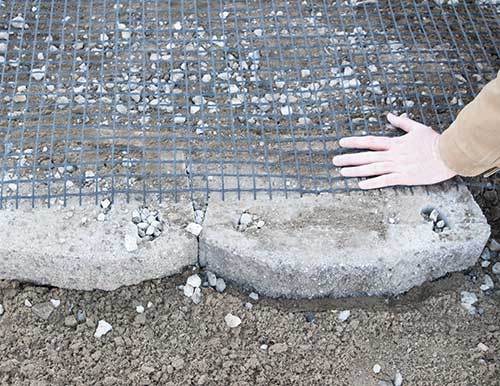 Common Geogrid Applications Common Geogrid Applications
Being such a
reliable reinforcing agent, builders have found many ways to incorporate geogrid into the construction process. Here are some of the most common
applications:
• Roads
• Retaining walls
• Slope and soil stabilization
In the following sections, you'll see how biaxial grids benefit the
construction of the elements listed above. You'll also learn a little bit about
how to use biaxial grids in these applications.
Geogrid in Road Construction
Incorporating a geogrid is now a common
practice in road construction. Biaxial geogrids are an especially useful option.
Below is a basic outline of a road construction process. We'll focus on the part
of the process where the geogrid comes into play:
1. Excavate the
road exposing the subgrade
2. Compact the subgrade
3. Roll the geogrid over the compacted subgrade
4. Connect the geogrid via heavy-duty zip
ties
5. Pour aggregate over the geogrid
6. Compact the aggregate
on top of the geogrid
7. Complete paving for the base and wearing
courses as required
Using the geogrid increases the roadway's
lifespan. It does so by increasing the strength of the subgrade. It also more
evenly distributes the weight of vehicles as they travel along the road. (for additional reinforcement options see our
3-D grid products)
This reduces the amount of cracking that commonly occurs in paved roads.
Geogrids in Retaining Wall Construction
Retaining walls are constantly holding the static force of soil and water that
builds up behind them. When this hydrostatic force exceeds the amount the wall
can handle, the wall will fail.
Retaining wall failures are a serious
safety risk. As such, builders should take every possible precaution to prevent
failure.
One of the best ways to do this is to use a biaxial grid. While
retaining walls are often made of heavy stones, these stones alone are often not
structurally sufficient.
Adding a geogrid to your retaining wall is
relatively simple. Here are some basic steps for using a geogrid in your
retaining wall construction:
1. As you layer courses of stone, lay layers
of geogrid as well
2. The geogrid should run perpendicular to
the face of the wall
3. The geogrid should extend a few feet behind
the wall
4. Backfill as you add courses and geogrid layers
The
layers of geogrid reinforce the mass of soil behind the wall. This
reduces the pressure placed on the wall itself and can reduce the possibility of
failure to a significant degree.
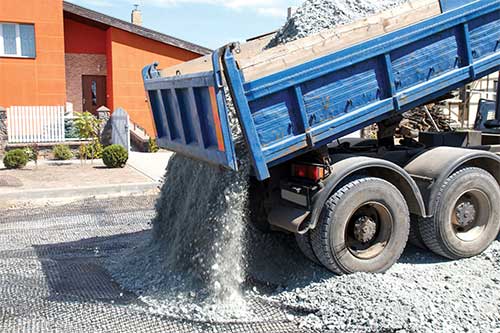 Different Geogrids for Different
Designs Different Geogrids for Different
Designs
When talking about construction projects and laying
foundations, the tendency is to think in terms of flat, level surfaces. While
these are desirable conditions for building, there will be times when the earth
needs to be held in place in a conspicuously angled manner. Some situations in
which soil will need to be held at odd angles include:
- When building retaining walls in hilly or terraced subdivisions
to ensure that the hill's edge does not crumble and cause erosion in the
area
- It should be noted that this was the initial use of geogrids, as
architects soon found out that geogrids were more effective and
versatile (not to mention more affordable) than concrete retaining
walls.
- In the construction of manmade ponds that will be used
as a receptacle for storm runoff
- When laying roadways through mountain passes. Not only
will the underlying road foundation need to be adequately secured, but there
will also need to be some kind of retention in place on the mountainside to
prevent falling rock and other debris from making its way onto the highway
and putting traffic at risk
Because there are many ways soil needs to be held in place, the best geogrid
for one project may not be the best geogrid for another.
Fortunately, there
are three distinct types of geogrids engineered with properties that can serve
projects in several conditions. Each time is designed and fabricated for
specific construction applications with various tensile strengths:
Uniaxial Geogrid
This is arguably the most common type of
geogrid used in construction, designed to withstand forces coming from one
direction. During manufacturing, these geogrids have their ribs stretched in a
longitudinal direction, while their tensile strength is pushed in another
direction.
This type of geogrid is ideal for various purposes, such as
retaining walls and steep slopes, landfill liners, and embankments over soft
soils.
Biaxial Geogrid
These geogrids have equal
strength in two directions; this allows the geogrid to distribute weight over a
vast area, which increases its effectiveness in base stabilization projects.
Geogrids are ideal for foundation work, such as preparing the ground
to lay roads, building airport runways, parking lots, working platforms on weak
subgrades, and railroads.
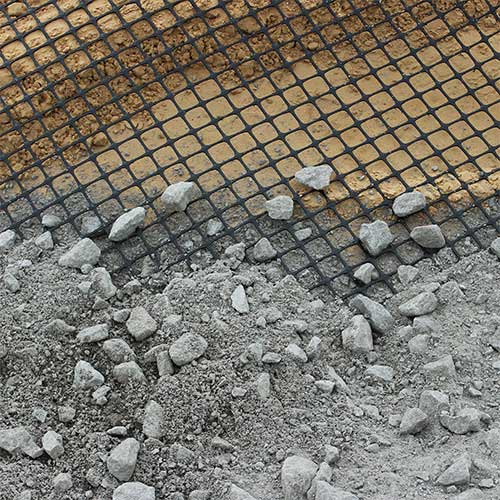 Biaxial Geogrid Performs
Well in All Weather Biaxial Geogrid Performs
Well in All Weather
A primary concern for some users may center
around how geogrid performs across the seasons and its capabilities in different
climates. Does extreme heat and humidity cause the material to rot and
breakdown? Will freezing and thawing cause geogrids to expand and crack? Do dry,
arid climates make it difficult for geogrid to perform as intended when dealing
with coarse, sandy soil?
The answer to all these questions is that
geogrids perform exceptionally well across all types of weather.
They do not break down or lose their abilities in the presence of extreme heat
or cold, so you can feel just as good about using geogrid to hold the ground in
place along the sunny beaches of Florida as you can in the frozen tundra of a
Midwest winter.
Geogrid in Slope and Soil Stabilization
The process for stabilizing a constructed slope with geogrid is similar
to that of the retaining wall described above.
The difference is that
the slope is not steep enough to require a full retaining wall. However, the
slope is steep enough to cause an erosion concern.
When building a slope,
lay the soil in layers. Add geogrid at even increments as separations
between layers of soil.
As with the retaining wall, the geogrid
should lay horizontal to the ground. You can vary the depth of the geogrid to improve stability.
This method allows you to build slopes that
are steeper than those that would occur naturally. As slopes become steeper, the
speed of the water running across their surface also increases. This amplifies
the erosion effect.
Including geogrids is a great way to build
when steep slopes are needed. Some common scenarios include the following:
- Landfills
- Highway embankments
- Privacy berms
After building these landforms, add plants as well to enhance stability
further. Another final treatment to reduce erosion is to use stone facing.
Regardless of which method you choose, the geogrid will greatly increase
your slopes' structural integrity.
In addition: In addition to geogrid products, gravel grid panels which feature 3-D cell structures are also an excellent way to stabilize roadways and parking lots for vehicular traffic.
Conclusion
Biaxial
geogrids are especially useful because of their ability to lock soils and add
strength in multiple directions. Next time you work on a construction project,
make sure that it will stand the test of time by using a biaxial grid.
Sources:
https://www.versa-lok.com/products/geo-grid/
https://theconstructor.org/building/geogrids-types-functions-applications-advantages/15190/
https://happho.com/geogrids-manufacturing-process-applications-advantages/
|